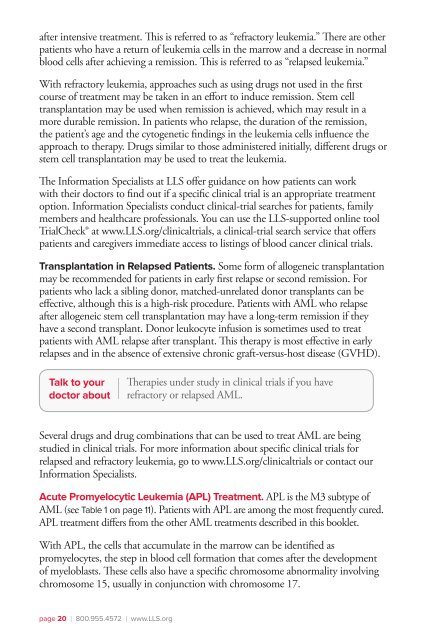Acute Myeloid Leukemia - The Leukemia & Lymphoma Society
Acute Myeloid Leukemia - The Leukemia & Lymphoma Society
Acute Myeloid Leukemia - The Leukemia & Lymphoma Society
- No tags were found...
You also want an ePaper? Increase the reach of your titles
YUMPU automatically turns print PDFs into web optimized ePapers that Google loves.
after intensive treatment. This is referred to as “refractory leukemia.” <strong>The</strong>re are otherpatients who have a return of leukemia cells in the marrow and a decrease in normalblood cells after achieving a remission. This is referred to as “relapsed leukemia.”With refractory leukemia, approaches such as using drugs not used in the firstcourse of treatment may be taken in an effort to induce remission. Stem celltransplantation may be used when remission is achieved, which may result in amore durable remission. In patients who relapse, the duration of the remission,the patient’s age and the cytogenetic findings in the leukemia cells influence theapproach to therapy. Drugs similar to those administered initially, different drugs orstem cell transplantation may be used to treat the leukemia.<strong>The</strong> Information Specialists at LLS offer guidance on how patients can workwith their doctors to find out if a specific clinical trial is an appropriate treatmentoption. Information Specialists conduct clinical-trial searches for patients, familymembers and healthcare professionals. You can use the LLS-supported online toolTrialCheck® at www.LLS.org/clinicaltrials, a clinical-trial search service that offerspatients and caregivers immediate access to listings of blood cancer clinical trials.Transplantation in Relapsed Patients. Some form of allogeneic transplantationmay be recommended for patients in early first relapse or second remission. Forpatients who lack a sibling donor, matched-unrelated donor transplants can beeffective, although this is a high-risk procedure. Patients with AML who relapseafter allogeneic stem cell transplantation may have a long-term remission if theyhave a second transplant. Donor leukocyte infusion is sometimes used to treatpatients with AML relapse after transplant. This therapy is most effective in earlyrelapses and in the absence of extensive chronic graft-versus-host disease (GVHD).Talk to yourdoctor about<strong>The</strong>rapies under study in clinical trials if you haverefractory or relapsed AML.Several drugs and drug combinations that can be used to treat AML are beingstudied in clinical trials. For more information about specific clinical trials forrelapsed and refractory leukemia, go to www.LLS.org/clinicaltrials or contact ourInformation Specialists.<strong>Acute</strong> Promyelocytic <strong>Leukemia</strong> (APL) Treatment. APL is the M3 subtype ofAML (see Table 1 on page 11). Patients with APL are among the most frequently cured.APL treatment differs from the other AML treatments described in this booklet.With APL, the cells that accumulate in the marrow can be identified aspromyelocytes, the step in blood cell formation that comes after the developmentof myeloblasts. <strong>The</strong>se cells also have a specific chromosome abnormality involvingchromosome 15, usually in conjunction with chromosome 17.page 20 I 800.955.4572 I www.LLS.org
















